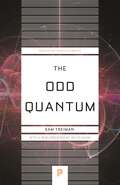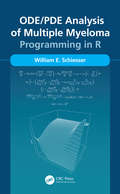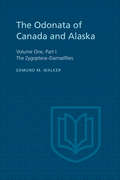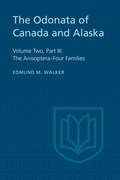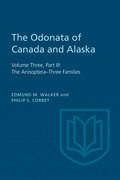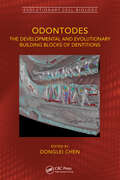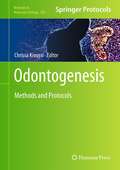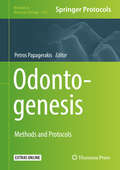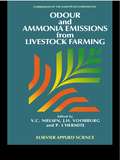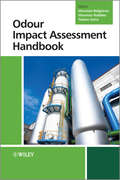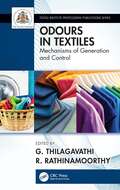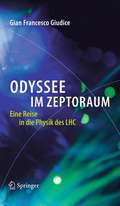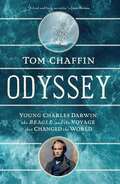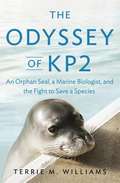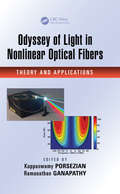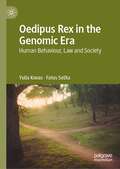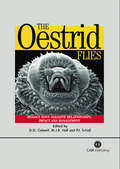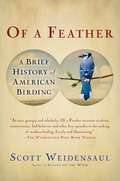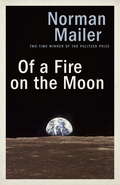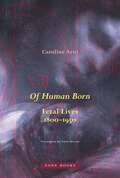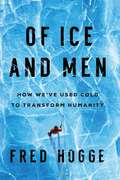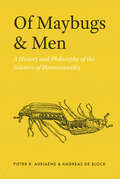- Table View
- List View
The Odd Quantum (Princeton Science Library #141)
by Sam TreimanAn acclaimed physicist’s accessible yet rigorous introduction to quantum mechanics for nonspecialistsThis is a rare and much-needed book: a concise but comprehensive account of quantum mechanics for popular science readers written by a respected physicist. Sam Treiman—who was internationally renowned for his work in particle physics—makes quantum mechanics accessible to nonspecialists. Combining mastery of the material with clear, elegant prose and infectious enthusiasm, he conveys the substance, methods, and profound oddities of the field.Treiman begins with an overview of quantum mechanics. He sketches the early development of the field by Einstein, Bohr, Heisenberg, Schrödinger, and others, and he makes clear how the quantum outlook flies in the face of common sense. As he explains, the quantum world is intrinsically probabilistic. For example, a particle is not in general in some particular place at a given instant, nor does it have a definite momentum. According to the Heisenberg uncertainty principle, there is a limit to how well both location and momentum can be specified simultaneously. In addition, particles can move through barriers and otherwise move in regions of space that are forbidden by classical mechanics. If a particle has a choice of different paths, it pursues all of them at once. Particles display wave-like characteristics and waves show particle-like characteristics. Treiman pays special attention to the more fundamental wave outlook and its expression in quantum field theory. He deals here with the remarkable fact that all the particles of a given species are strictly identical, and with the unnerving fact that particles can be created and destroyed. As Treiman introduces us to these and other wonders, he also touches—without resolution—on some of the deep philosophical problems of quantum mechanics, notably how probabilities become facts.Weaving together impeccable science, engaging writing, and a talent for clear explanation honed over Treiman's distinguished career as a physicist and teacher, The Odd Quantum is a remarkable survey of a field that changed the course of modern scientific and philosophical thought.
ODE/PDE Analysis of Multiple Myeloma: Programming in R
by William E. SchiesserMultiple myeloma is a form of bone cancer. Specifically, it is a cancer of the plasma cells found in bone marrow (bone soft tissue). Normal plasma cells are an important part of the immune system. Mathematical models for multiple myeloma based on ordinary and partial differential equations (ODE/PDEs) are presented in this book, starting with a basic ODE model in Chapter 1, and concluding with a detailed ODE/PDE model in Chapter 4 that gives the spatiotemporal distribution of four dependent variable components in the bone marrow and peripheral blood: (1) protein produced by multiple myeloma cells, termed the M protein, (2) cytotoxic T lymphocytes (CTLs), (3) natural killer (NK) cells, and (4) regulatory T cells (Tregs). The computer-based implementation of the example models is presented through routines coded (programmed) in R, a quality, open-source scientific computing system that is readily available from the Internet. Formal mathematics is minimized, e.g., no theorems and proofs. Rather, the presentation is through detailed examples that the reader/researcher/analyst can execute on modest computers using the R routines that are available through a download. The PDE analysis is based on the method of lines (MOL), an established general algorithm for PDEs, implemented with finite differences.
The Odonata of Canada and Alaska: The Zygoptera–Damselflies
by Edmund WalkerDr. Walker makes a signal contribution in gathering together all available information on the dragonflies of Canada and Alaska. The order as a whole and the zygoptera are covered. The treatment is not confined to taxonomy and geographical distribution, but includes data on habitats, seasons of adult life, and brief notes on habits when these are available.
The Odonata of Canada and Alaska: The Anisoptera–Four Families
by Edmund WalkerDr. Walker makes a signal contribution in gathering together all available information on the dragonflies of Canada and Alaska. The order as a whole and the zygoptera are covered. The treatment is not confined to taxonomy and geographical distribution, but includes data on habitats, seasons of adult life, and brief notes on habits when these are available.
The Odonata of Canada and Alaska: The Anisoptera–Three Families
by Edmund Walker Philip CorbetDr. Walker and Dr. Corbet make a signal contribution in gathering together all available information on the dragonflies of Canada and Alaska. The order as a whole and the zygoptera are covered. The treatment is not confined to taxonomy and geographical distribution, but includes data on habitats, seasons of adult life, and brief notes on habits when these are available.
Odontodes: The Developmental and Evolutionary Building Blocks of Dentitions (Evolutionary Cell Biology)
by Donglei ChenThe odontode system, which encompasses teeth and other dentine-based structures, is ancient. Odontodes are present in the oldest vertebrate fossils, dating back 500 million years, and still play an important role in the anatomy and function of living jawed vertebrates. Fossils preserve odontode tissues with remarkable nanoscale fidelity, allowing the evolution and diversification of the odontode system to be studied in deep time as well as across the diversity of living vertebrates. This synthetic volume presents an overview of odontode research by internationally leading researchers from different fields of biology.. Key Features Summarizes classic and cutting-edge research devoted to the development and evolution Focuses on the cellular aspects of odontogenesis Documents the structural and functional diversity of odontode tissues Describes the patterning mechanisms of dentitions in various vertebrate groups Provides a thorough index for students
Odontogenesis
by Chrissa KioussiOnly in recent times has the possibility of growing and implanting replacement teeth, made from one's own cells, moved into the realm of realistic possibilities; however, the molecular and cellular mechanisms of tooth development must be studied in a range of vertebrates, from zebrafish to mice, so that evolutionarily conserved network kernels, which will define the cellular states of generic vertebrate tooth development, can be recognized. In Odontogenesis: Methods and Protocols, experts in the field examine techniques to approach this burgeoning field. This detailed volume includes chapters on the detection of "tooth development" gene expression, both at the RNA and protein level, current approaches to the manipulation of gene expression levels and subsequent analysis of tooth phenotypes, as well as chapters concerning current efforts to get living tooth implants working without waiting for a full understanding of the developmental pathways at the molecular level. Written in the highly successful Methods in Molecular BiologyTM series format, chapters include introductions to their respective topics, lists of the necessary materials and reagents, step-by-step, readily reproducible laboratory protocols, and tips for troubleshooting and avoiding known pitfalls. Practical and easy to use, Odontogenesis: Methods and Protocols aims to help researchers move forward toward the ultimate goal of getting a "bioengineered tooth" into the patient's mouth.
Odontogenesis: Methods and Protocols (Methods in Molecular Biology #1922)
by Petros PapagerakisThis volume provides methods and approaches to study genetic and environmental regulatory controls on odontogenesis. Chapters guide readers through protocols for isolation and characterization of both epithelial and mesenchymal dental cells, methods on isolation, phenotypic characterization, expansion, differentiation, immunofluorescence, in situ hybridization, immunohistochemistry, imaging protocols, rodent dental fluorosis model, 3D assessment of crown size, dental diseases models, next generation sequencing, genetic and epigenetic studies, genome-wide association studies as well as clinical protocols for measurement of early childhood caries and saliva, and supragingival fluids and biofilm collection and subsequent analyses. Written in the highly successful Methods in Molecular Biology series format, chapters include introductions to their respective topics, lists of the necessary materials and reagents, step-by-step, readily reproducible laboratory protocols, and tips on troubleshooting and avoiding known pitfalls. Authoritative and cutting-edge, Odontogenesis: Methods and Protocols aims to guide researchers towards elucidating the secrets and mysteries of a fascinating and unique organ, the tooth.
Odour and Ammonia Emissions from Livestock Farming
by V. C. Nielsen J. H. Voorburg P. L’HermiteProceedings of a seminar held in Silsoe, UK, 26-28 March 1990.
Odour Impact Assessment Handbook
by Tiziano Zarra Vincenzo Naddeo Vincenzo BelgiornoOdours have become a priority concern for facility operators, engineers and urban planners who deal with waste and industrial treatment plants. The subjectivity of smell perception, its variability due to frequency and weather conditions, and the complex nature of the substances involved, has long hampered the regulation of odour emissions.This book provides a comprehensive framework for the assessment, measurement and monitoring of odour emissions, and covers: Odour characterization and exposure effectsInstruments and methods for sampling and measurementStrategies for odour controlDispersion modelling for odour exposure assessmentOdour regulations and policiesProcedures for odour impact assessmentCase studies: Wastewater treatment, composting, industrial and CAFO plants, and landfillIntended for researchers in environmental chemistry, environmental engineering, and civil engineering, this book is also an invaluable guide for industry professionals working in wastewater treatment, environmental and air analysis, and waste management.
Odour in Textiles: Generation and Control (Textile Institute Professional Publications)
by G. ThilagavathiOdour in Textiles: Generation and Control presents the essential science and mechanisms behind the formation of odours in textiles. It discusses consumer perception of odour in clothing, the mechanism of odour formation in the skin, and the role of textile fibres and structures in odour formation. It also discusses odour controls and testing methods available for measurement of odours in textiles. Features: • Fills a gap in the literature as the first book to focus on textile and odour interaction • Discusses microbiological aspects of odour formation in simple terms • Details the role of textile fibres and structures on odour formation • Describes various testing methods, standards, and regulatory norms for odour analysis This book will appeal to a broad audience, including industry professionals in the textiles industry, hygiene and health care, the chemical and finishing industry, and odour measurement and testing. It will also interest advanced students and research scholars studying textile engineering, clothing science, and fashion design.
Odyssee im Zeptoraum
by Gian Francesco GiudiceDer Band lädt Leser ein, die Teilchenphysik mit den Augen eines Insiders zu betrachten, dadurch bieten sich neue Einblicke in die Welt der Teilchen und ihrer Wechselwirkungen. Aufschlussreich und unterhaltsam thematisieren die Autoren die Geschichte des Large Hadron Collider (LHC) und erläutern die mit dem LHC verknüpften wissenschaftlichen Fragen: Existiert das mysteriöse Higgs-Teilchen wirklich? Erstreckt sich der Raum in zusätzliche Dimensionen? Das Buch verhilft dazu, die Entdeckungen der kommenden Jahre mitzuverfolgen und nachzuvollziehen.
Odyssee im Zeptoraum: Eine Reise in die Physik des LHC
by Gian Francesco GiudiceDer Band lädt Leser ein, die Teilchenphysik mit den Augen eines Insiders zu betrachten, dadurch bieten sich neue Einblicke in die Welt der Teilchen und ihrer Wechselwirkungen. Aufschlussreich und unterhaltsam thematisieren die Autoren die Geschichte des Large Hadron Collider (LHC) und erläutern die mit dem LHC verknüpften wissenschaftlichen Fragen: Existiert das mysteriöse Higgs-Teilchen wirklich? Erstreckt sich der Raum in zusätzliche Dimensionen? Das Buch verhilft dazu, die Entdeckungen der kommenden Jahre mitzuverfolgen und nachzuvollziehen.
Odyssey: Young Charles Darwin, The Beagle, and The Voyage that Changed the World
by Tom ChaffinAn illuminating and lively narrative of Charles Darwin&’s formative years and adventurous voyage aboard the H.M.S. Beagle.Charles Darwin—alongside Isaac Newton and Albert Einstein—ranks among the world's most famous scientists. In popular imagination, he peers at us from behind a bushy white Old Testament beard. This image of Darwin the Sage, however, crowds out the vital younger man whose curiosities, risk-taking, and travels aboard HMS Beagle would shape his later theories and served as the foundation of his scientific breakthroughs. Though storied, the Beagle's voyage is frequently misunderstood, its mission and geographical breadth unacknowledged. The voyage's activities associated with South America—particularly its stop in the Galapagos archipelago, off Ecuador&’s coast—eclipse the fact that the Beagle, sailing in Atlantic, Pacific and Indian ocean waters, also circumnavigated the globe. Mere happenstance placed Darwin aboard the Beagle—an invitation to sail as a conversation companion on natural-history topics for the ship's depression-prone captain. Darwin was only twenty-two years old, an unproven, unknown, aspiring geologist when the ship embarked on what stretched into its five-year voyage. Moreover, conducting marine surveys of distance ports and coasts, the Beagle's purposes were only inadvertently scientific. And with no formal shipboard duties or rank, Darwin, after arranging to meet the Beagle at another port, often left the ship to conduct overland excursions. Those outings, lasting weeks, even months, took him across mountains, pampas, rainforests, and deserts. An expert horseman and marksman, he won the admiration of gauchos he encountered along the way. Yet another rarely acknowledged aspect of Darwin's Beagle travels, he also visited, often lingered in, cities—including Rio de Janeiro, Buenos Aires, Montevideo, Santiago, Lima, Sydney, and Cape Town; and left colorful, often sharply opinionated, descriptions of them and his interactions with their residents. In the end, Darwin spent three-fifths of his five-year "voyage" on land—three years and three months on terra firma versus a total 533 days on water. Acclaimed historian Tom Chaffin reveals young Darwin in all his complexities—the brashness that came from his privileged background, the Faustian bargain he made with Argentina's notorious caudillo Juan Manuel de Rosas, his abhorrence of slavery, and his ambition to carve himself a place amongst his era's celebrated travelers and intellectual giants. Drawing on a rich array of sources— in a telling of an epic story that surpasses in breadth and intimacy the naturalist's own Voyage of the Beagle—Chaffin brings Darwin's odyssey to vivid life.
The Odyssey of KP2
by Terrie M. WilliamsWhen a two-day old Hawaiian monk seal named Kauai Pup 2, or KP2, is attacked and abandoned, environmental officials must decide whether to save the new-born animal or allow nature to take its course. Being one of only 1100 remaining Hawaiian monk seals, and facing certain extinction within 50 years, this decision is a particularly difficult one. KP2 is soon rushed on a journey, taking him across the ocean and into the lab of eminent wildlife biologist Dr. Terrie M. Williams, an expert who refuses to give up on KP2 and his species.
Odyssey of Light in Nonlinear Optical Fibers: Theory and Applications
by Kuppuswamy Porsezian Ramanathan GanapathyOdyssey of Light in Nonlinear Optical Fibers: Theory and Applications presents a collection of breakthrough research portraying the odyssey of light from optical solitons to optical rogue waves in nonlinear optical fibers. The book provides a simple yet holistic view on the theoretical and application-oriented aspects of light, with a special focus on the underlying nonlinear phenomena. <P><P>Exploring the very frontiers of light-wave technology, the text covers the basics of nonlinear fiberoptics and the dynamics of electromagnetic pulse propagation in nonlinear waveguides. It also highlights some of the latest advances in nonlinear optical fiber technology, discussing hidden symmetry reductions and Ablowitz–Kaup–Newell–Segur (AKNS) hierarchies for nonautonomous solitons, state-of-the-art Brillouin scattering applications, backpropagation, and the concept of eigenvalue communication—a powerful nonlinear digital signal processing technique that paves the way to overcome the current limitations of traditional communications methods in nonlinear fiber channels. <P><P>Key chapters study the feasibility of the eigenvalue demodulation scheme based on digital coherent technology by throwing light on the experimental study of the noise tolerance of the demodulated eigenvalues, investigate matter wave solitons and other localized excitations pertaining to Bose–Einstein condensates in atom optics, and examine quantum field theory analogue effects occurring in binary waveguide arrays, plasmonic arrays, etc., as well as their ensuing nonlinear wave propagation. Featuring a foreword by Dr. Akira Hasegawa, the father of soliton communication systems, Odyssey of Light in Nonlinear Optical Fibers: Theory and Applications serves as a curtain raiser to usher in the photonics era. The technological innovations at the core of the book form the basis for the next generation of ultra-high speed computers and telecommunication devices.
Oedipus Rex in the Genomic Era: Human Behaviour, Law and Society
by Yulia Kovas Fatos SelitaThis book explores the answers to fundamental questions about the human mind and human behaviour with the help of two ancient texts. The first is Oedipus Rex (Oedipus Tyrannus) by Sophocles, written in the 5th century BCE. The second is human DNA, with its origins around 4 billion years ago, and continuously revised by chance and evolution. With Sophocles as a guide, the authors take a journey into the Genomic era, an age marked by ever-expanding insights into the human genome. Over the course of this journey, the book explores themes of free will, fate, and chance; prediction, misinterpretation, and the burden that comes with knowledge of the future; self-fulfilling and self-defeating prophecies; the forces that contribute to similarities and differences among people; roots and lineage; and the judgement of oneself and others.Using Oedipus Rex as its lens, this novel work provides an engaging overview of behavioural genetics that demonstrates its relevance across the humanities and the social and life sciences. It will appeal in particular to students and scholars of genetics, education, psychology, sociology, and law.
The Oestrid Flies: Biology, Host-parasite Relationships, Impact and Management
by D. D. Colwell P. J. Scholl M. J. R. HallThis book provides an in-depth review and analysis of the biology of adults and larvae of the Family Oestridae (commonly known as botflies, or warble flies). Oestrid flies cause myiasis (invasion of living tissue by the larvae), and are a major pest of both domestic and wild animals worldwide. The book presents a comparative investigation of the life histories and adaptation to parasitism exhibited by this unique family of flies. It also gives a detailed survey of each genus and provides a synopsis of the taxonomy of the family. It contains chapters on morphology, life history, host-parasite relationships, taxonomy and behavior.
Of a Feather: A Brief History of American Birding
by Scott WeidensaulEuropeans were awestruck by a continent awash with birds. Today tens of millions of Americans birders have made a once eccentric hobby into something so mainstream its (almost) cool. Scott Weidensaul traces the colorful evolution of American birding.
Of a Fire on the Moon
by Norman MailerFor many, the moon landing was the defining event of the twentieth century. So it seems only fitting that Norman Mailer--the literary provocateur who altered the landscape of American nonfiction--wrote the most wide-ranging, far-seeing chronicle of the Apollo 11 mission. A classic chronicle of America's reach for greatness in the midst of the Cold War, Of a Fire on the Moon compiles the reportage Mailer published between 1969 and 1970 in Life magazine: gripping firsthand dispatches from inside NASA's clandestine operations in Houston and Cape Kennedy; technical insights into the magnitude of their awe-inspiring feat; and prescient meditations that place the event in human context as only Mailer could.
Of Apes and Ancestors
by Ian HeskethTell me, sir, is it on your grandmother's or your grandfather's side that you are descended from an ape?In June of 1860, some of Britain's most influential scientific and religious authorities gathered in Oxford to hear a heated debate on the merits of Charles Darwin's recently published Origin of Species. The Bishop of Oxford, "Soapy" Samuel Wilberforce, clashed swords with Darwin's most outspoken supporter, Thomas Henry Huxley. The latter's triumph, amid quips about apes and ancestry, has become a mythologized event, symbolizing the supposed war between science and Christianity. But did the debate really happen in this way? Of Apes and Ancestors argues that this one-dimensional interpretation was constructed and disseminated by Darwin's supporters, becoming an imagined victory in the struggle to overcome Anglican dogmatism. By reconstructing the Oxford debate and carefully considering the individual perspectives of the main participants, Ian Hesketh argues that personal jealousies and professional agendas played a formative role in shaping the response to Darwin's hypothesis, with religious anxieties overlapping with a whole host of other cultural and scientific considerations. An absorbing study, Of Apes and Ancestors sheds light on the origins of a debate that continues, unresolved, to this day.
Of Human Born: Fetal Lives, 1800–1950
by Caroline ArniA new history of the concept of fetal life in the human sciencesAt a time when the becoming of a human being in a woman&’s body has, once again, become a fraught issue—from abortion debates and surrogacy controversies to prenatal diagnoses and assessments of fetal risk—Of Human Born presents the largely unknown history of how the human sciences came to imagine the unborn in terms of &“life before birth.&”Caroline Arni shows how these sciences created the concept of &“fetal life&” by way of experimenting on animals, pregnant women, and newborns; how they worried about the influence of the expectant mother&’s living conditions; and how they lingered on the question of the beginnings of human subjectivity. Such were the concerns of physiologists, pediatricians, psychologists, and psychoanalysts as they advanced the novel discipline of embryology while, at the same time, grappling with age-old questions about the coming-into-being of a human person. Of Human Born thus draws attention to the fundamental way in which modern approaches to the unborn have been intertwined with the configuration of &“the human&” in the age of scientific empiricism.Arni revises the narrative that the &“modern embryo&” is quintessentially an embryo disembedded from the pregnant woman&’s body. On the contrary, she argues that the concept of fetal life cannot be separated from its dependency on the maternal organism, countering the rhetorical discourses that have fueled the recent rollback of abortion rights in the United States.
Of Ice and Men: How We've Used Cold to Transform Humanity
by Fred HoggeAn exploration of humanity&’s relationship with ice since the dawn of civilization, Of Ice and Men reminds us that only by understanding this unique substance can we save the ice on our planet—and perhaps ourselves.Ice tells a story. It writes it in rock. It lays it down, snowfall by snowfall at the ends of the earth where we may read it like the rings on a tree. It tells our planet&’s geological and climatological tale. Ice tells another story too: a story about us. It is a tale packed with swash-buckling adventure and improbable invention, peopled with driven, eccentric, often brilliant characters. It tells how our species has used ice to reshape the world according to our needs and our desires: how we have survived it, harvested it, traded it, bent science to our will to make it—and how in doing so we have created globe-spanning infrastructures that are entirely dependent upon it. And even after we have done all that, we take ice so much for granted that we barely notice it. Ice has supercharged the modern world. It has allowed us to feed ourselves and cure ourselves in ways unimaginable two hundred years ago. It has enabled the global population to rise from less than 1 billion to nearly 7½ billion—which just happens to cover the same period of time as humanity has harvested, manufactured, and distributed ice on an industrial scale. And yet the roots of our fascination with ice and its properties run much deeper than the recent past.
Of Matters Great and Small
by Isaac AsimovMy beautiful, blonde-haired, blue-eyed daughter had not been at college long when word reached her that a certain young man W.15 dying to meet her, presumably, she was given to understand, to feast his eyes on her beauty. After some ladylike show of reluctance, Robyn agreed to allow the meeting. In came the young man, eyes wide. "Tell me," he said, choking a bit, "are you really the daughter of Isaac Asimov?" Now, if I had started this essay with: "The two chief methods by which a radioactive nucleus can break down involve, one..." would you have plunged in quite as rapidly as you would with a beginning like: "My beautiful, blonde-haired, blue-eyed daughter "? Tell the truth...
Of Maybugs and Men: A History and Philosophy of the Sciences of Homosexuality
by Pieter R. Adriaens Andreas De BlockA much-needed exploration of the history and philosophy of scientific research into male homosexuality. Questions about the naturalness or unnaturalness of homosexuality are as old as the hills, and the answers have often been used to condemn homosexuals, their behaviors, and their relationships. In the past two centuries, a number of sciences have involved themselves in this debate, introducing new vocabularies, theories, arguments, and data, many of which have gradually helped tip the balance toward tolerance and even acceptance. In this book, philosophers Pieter R. Adriaens and Andreas De Block explore the history and philosophy of the gay sciences, revealing how individual and societal values have colored how we think about homosexuality. The authors unpack the entanglement of facts and values in studies of male homosexuality across the natural and human sciences and consider the extent to which science has mitigated or reinforced homonegative mores. The focus of the book is on homosexuality’s assumed naturalness. Geneticists rephrased naturalness as innateness, claiming that homosexuality is innate—colloquially, that homosexuals are born gay. Zoologists thought it a natural affair, documenting its existence in myriad animal species, from maybugs to men. Evolutionists presented homosexuality as the product of natural selection and speculated about its adaptive value. Finally, psychiatrists, who initially pathologized homosexuality, eventually appealed to its naturalness or innateness to normalize it. Discussing findings from an array of sciences—comparative zoology, psychiatry, anthropology, evolutionary biology, social psychology, developmental biology, and machine learning—this book is essential reading for anyone interested in what science has to say about homosexuality.
